2014 MERCEDES-BENZ B-CLASS SPORTS ESP
[x] Cancel search: ESPPage 333 of 360

adapt your driving style to th
etraffic
conditions. Summer tires
Index Speed rating
Q up to 100mph (16
0km/h) R up to 106mph (17
0km/h) S up to 112mph (18
0km/h) T up to 118mph (19
0km/h) H up to 130mph (21
0km/h) V up to 149mph (24
0km/h) W up to 168mph (27
0km/h) Y up to 186mph (30
0km/h) ZR...Y up to 186mph (30
0km/h) ZR...(..Y) ove
r186mp h(30 0k m/h) ZR ove
r149mp h(24 0k m/h) R
Optionally, tires wit hamaximum spee dof
ove r149 mph (240km/h) may have "ZR" in
the size description, depending on the
manufacture r(e.g. 245/40 ZR 18).
The service specifications consist of load
bearing index 001Eand spee drating 0024.
R If the size description of you rtire includes
"ZR" and there are no service
specifications, ask the tir emanufacturer in
order to fin dout the maximum speed.
If as ervice specification is available, the
maximum speed is limited accordin gtothe
speed rating in the service specification.
Example: 245/4 0ZR1897Y.Int his
example, "97 Y" is the service specification.
The letter "Y" represents the speed rating
and the maximum speed of the tir eis
limited to 186 mph (300km/h).
R The size description for all tires with
maximum speeds of over 186mph
(300km/h )must include "ZR", andthe service specification must be given in
brackets. Example: 275/4
0ZR18(99 Y).
The speed rating "(Y)" indicates that the
maximum speed of the tir eisover 186mph
(300km/h). Ask the tir emanufacturer
about the maximum speed. All-weather tires and winter tires
Index Speed rating
QM
+S4 up to 100mph (16
0km/ h) TM
+S4 up to 118mph (19
0km/ h) HM
+S4 up to 130mph (21
0km/ h) VM
+S4 up to 149mph (24
0km/ h) i
Not all tires with the M+S marking provide
the drivin gcharacteristics of winter tires.
Winter tires have, in additio ntothe M+S
identification, the 000Esnow flake symbol
on the tire sidewall. Tires with this marking
fulfill the requirements of the Rubber
Manufacturers Association (RMA) and the
Rubber Association of Canada (RAC)
regarding the tire traction on snow. They
have been especially developed for driving
on snow.
An electronic speed limiter prevent syour
vehicle from exceeding aspeed of 130mph
(210km/h).
The speed rating of tires mounted at the
factor ymay be higher than the maximum
speed that the electronic speed limiter
permits.
Make sure that your tires have the required
speed rating, e.g. when buying new tires. The
required speed rating for your vehicle can be
found in the "Tires" section (Y page 340).
Further information about reading tire data
can be obtained from any qualified specialist
workshop.
4 Or M+S000E for winter tires. Tirel
abeling
331Wheels and tires Z
Page 336 of 360
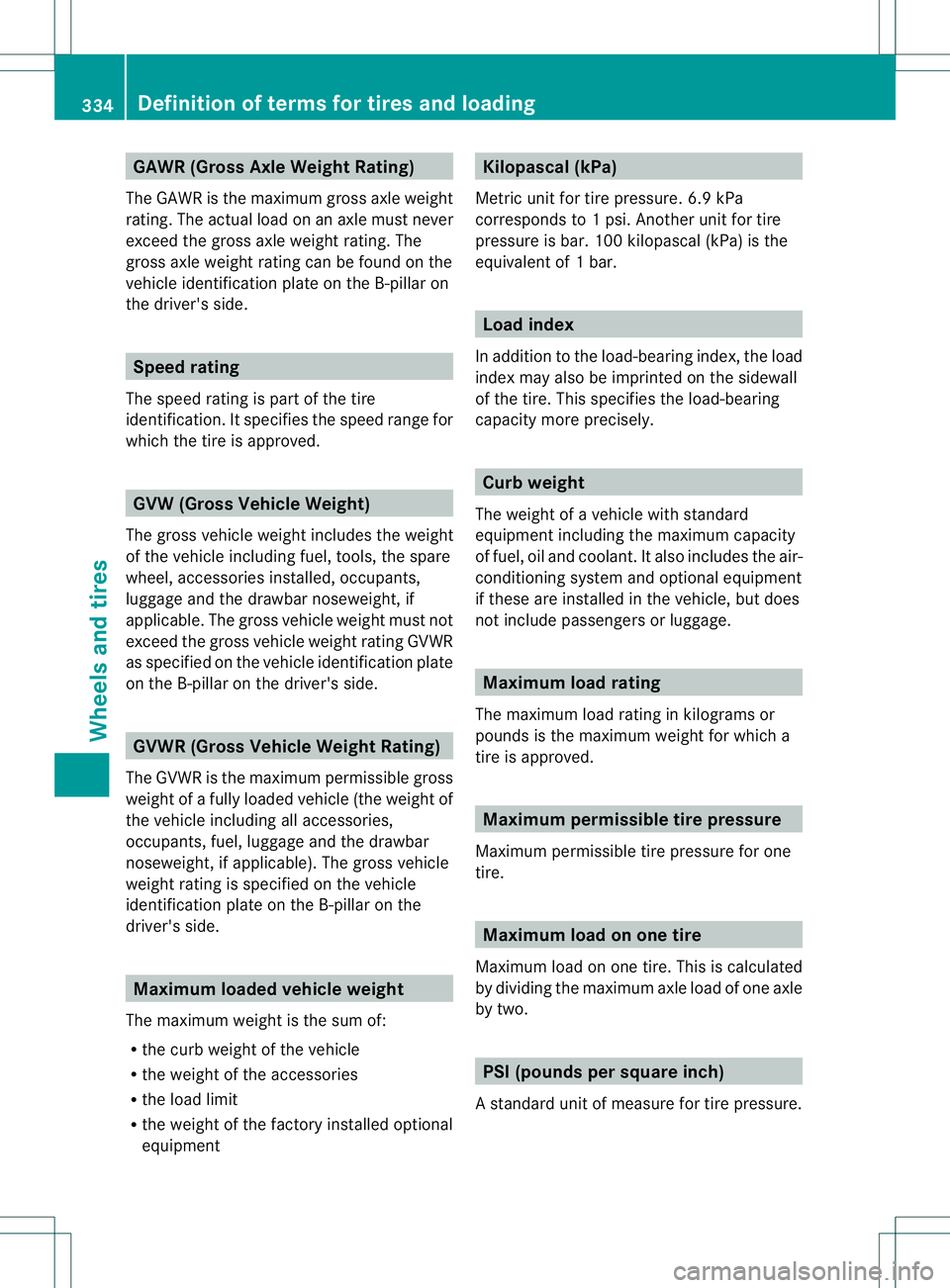
GAWR (Gross AxleW
eight Rating)
The GAWR is the maximu mgross axle weight
rating. The actua lloa donana xle must never
exceed the gross axle weight rating. The
gross axle weight rating can be found on the
vehicl eidentification plate on the B-pillar on
the driver's side. Speed rating
The spee drating is part of the tire
identification. It specifies the spee drange for
which the tire is approved. GVW (Gross Vehicle Weight)
The gross vehicl eweight includes the weight
of the vehicl eincluding fuel ,tools, the spare
wheel, accessories installed, occupants,
luggage and the drawbar noseweight, if
applicable.T he gross vehicle weight must not
exceed the gross vehicle weight rating GVWR
as specified on the vehicle identification plate
on the B-pillar on the driver's side. GVWR (Gross Vehicle Weight Rating)
The GVWR is the maximum permissible gross
weight of afully loaded vehicle (the weight of
the vehicle including all accessories,
occupants, fuel, luggage and the drawbar
noseweight, if applicable). The gross vehicle
weight rating is specified on the vehicle
identification plate on the B-pillar on the
driver's side. Maximum loaded vehicle weight
The maximum weight is the sum of:
R the curb weight of the vehicle
R the weight of the accessories
R the load limit
R the weight of the factory installed optional
equipment Kilopascal (kPa)
Metric unit for tire pressure. 6.9 kPa
corresponds to 1psi. Another unit for tire
pressure is bar. 100 kilopascal (kPa) is the
equivalent of 1bar. Load index
In addition to th eload-bearing index ,the load
index may also be imprinted on th esidewall
of th etire. This specifie sthe load-bearing
capacity more precisely. Curb weight
The weight of avehicle with standard
equipment including the maximum capacity
of fuel, oil and coolant. It also includes the air-
conditioning system and optional equipment
if these are installed in the vehicle, but does
not include passengers or luggage. Maximum load rating
The maximum load rating in kilograms or
pounds is the maximum weight for which a
tire is approved. Maximum permissible tire pressure
Maximum permissible tire pressure for one
tire. Maximum load on one tire
Maximum load on one tire. This is calculated
by dividing the maximum axle load of one axle
by two. PSI (pounds per squarei
nch)
As tandar dunitofm easure for tire pressure. 334
Definition of terms for tires and loadingWheels and tires
Page 341 of 360
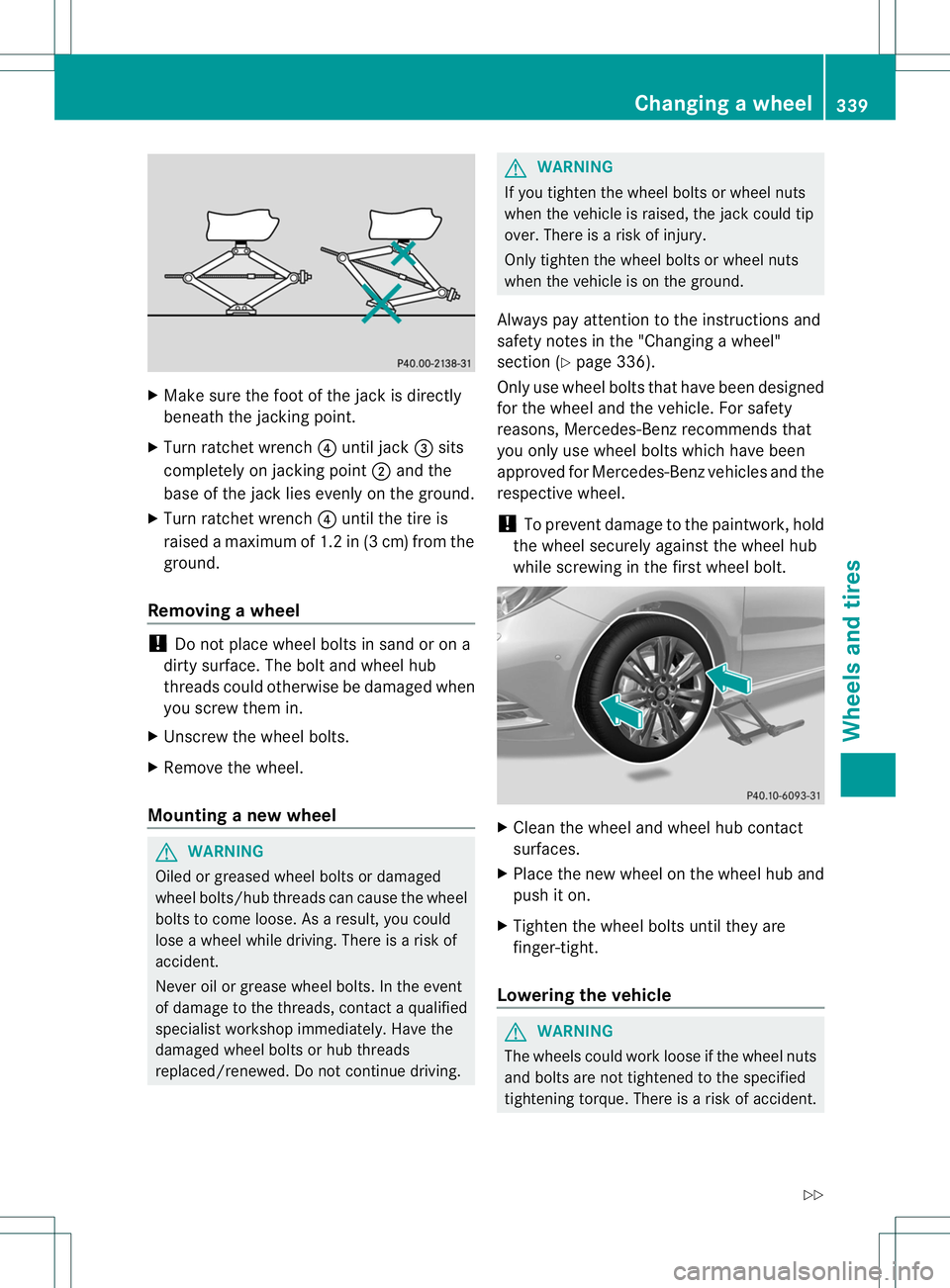
X
Make sure the foot of the jack is directly
beneath the jackingp oint.
X Turn ratchet wrench 0021until jack 0023sits
completely on jackingp oint0010and the
base of the jack lies evenly on the ground.
X Turn ratchet wrench 0021until the tire is
raised amaximum of 1. 2in(3cm)from the
ground.
Removing awheel !
Do not place wheel bolts in sand or on a
dirty surface. The bol tand whee lhub
thread scould otherwise be damage dwhen
yo us cre wthem in.
X Unscrew the whee lbolts.
X Remov ethe wheel.
Mounting anew wheel G
WARNING
Oiled or greased wheel bolt sordamaged
wheel bolts/hub threads can cause th ewheel
bolt stoc omeloose .Asa result, you could
lose awheel while driving. There is arisk of
accident.
Never oil or grease wheel bolts. In the event
of damage to the threads, contact aqualified
specialist workshop immediately.H ave the
damage dwheel bolt sorhub threads
replaced/renewed. Do no tcontinue driving. G
WARNING
If you tighten the wheel bolts or wheel nuts
when the vehicle is raised, the jack could tip
over. There is arisk of injury.
Only tighten the wheel bolts or wheel nuts
when the vehicle is on the ground.
Always pay attention to the instructions and
safety notes in the "Changing awheel"
section (Y page 336).
Only use wheel bolts that have been designed
for the wheel and the vehicle. For safety
reasons, Mercedes-Benz recommends that
you only use wheel bolts which have been
approved for Mercedes-Benz vehicles and the
respective wheel.
! To prevent damage to the paintwork, hold
the wheel securely against the wheel hub
while screwing in the first wheel bolt. X
Clean the wheel and wheel hub contact
surfaces.
X Place the new wheel on the wheel hub and
push it on.
X Tighten the wheel bolts until they are
finger-tight.
Lowering the vehicle G
WARNING
The wheels could work loose if the wheel nuts
and bolts are not tightened to the specified
tightening torque. There is arisk of accident. Changing
awheel
339Wheels and tires
Z
Page 342 of 360

Have the tightening torqu
eimmediately
checked at aqualifie dspecialist workshop
after awheel is changed. X
Place the ratche twrench onto the hexagon
nut of the jack so that the letters ABare
visible.
X Turn the ratchet wrench until the vehicl eis
once again standing firmly on the ground.
X Place the jack to one side.
X Tighten the whee lbolts evenly in a
crosswise pattern in the sequence
indicated ( 001Ato001E). The tightening torque
must be 96 lb-ft (130Nm ).
X Turn the jack back to its initia lposition.
X Stow the jack and the rest of the vehicle
tools in the vehicl eagain.
X Check the tire pressure of the newly
mounted whee land adjust it if necessary.
Observe the recommende dtire pressure
(Y page3 15). Wheel and tire combinations
General notes
! For safety reasons, Mercedes-Benz
recommends that you only use tires and
wheels which have been approved by
Mercedes-Benz specifically for your
vehicle. These tires have been speciallya
dapted for
use with the control systems ,such as ABS
or ESP ®
,a nd are marked as follows:
R MO =Mercedes-BenzO riginal
R MOE =Mercedes-BenzO riginal Extended
(tires featuring run-flat characteristics)
R MO1 =Mercedes-BenzO riginal (only
certain AMG tires)
Mercedes-Benz Original Extended tires
may only be used on wheels that have been
specificall yapproved by Mercedes-Benz.
Only use tires, wheels or accessories
tested and approved by Mercedes-Benz.
Certain characteristics, e.g. handling,
vehicl enoise emissions or fuel
consumption, may otherwise be adversely
affected. In addition, when driving with a
load, tire dimension variations coul dcause
the tires to come into contact with the
bodywork and axle components. This could
resul tind amage to th etires or th evehicle.
Mercedes-Ben zaccepts no liability for
damag eresulting from the us eoftires,
wheel soraccessorie sothe rthan those
tested and approved.
Information on tires, wheels and approved
combinations can be obtained from any
qualified specialist workshop.
! Retreaded tires are neither tested nor
recommended by Mercedes-Benz, since
previous damage cannot always be
detected on retreaded tires. As aresult,
Mercedes-Ben zcannot guarante evehicle
safety if retreade dtires are mounted. Do
no tm ount used tires if you have no
information about their previous usage.
Overview of abbreviations used in the
following tire tables:
R BA: both axles
R FA: front axle
R RA: rear axle 340
Wheel and tirec
ombinationsWheels and tires
Page 343 of 360
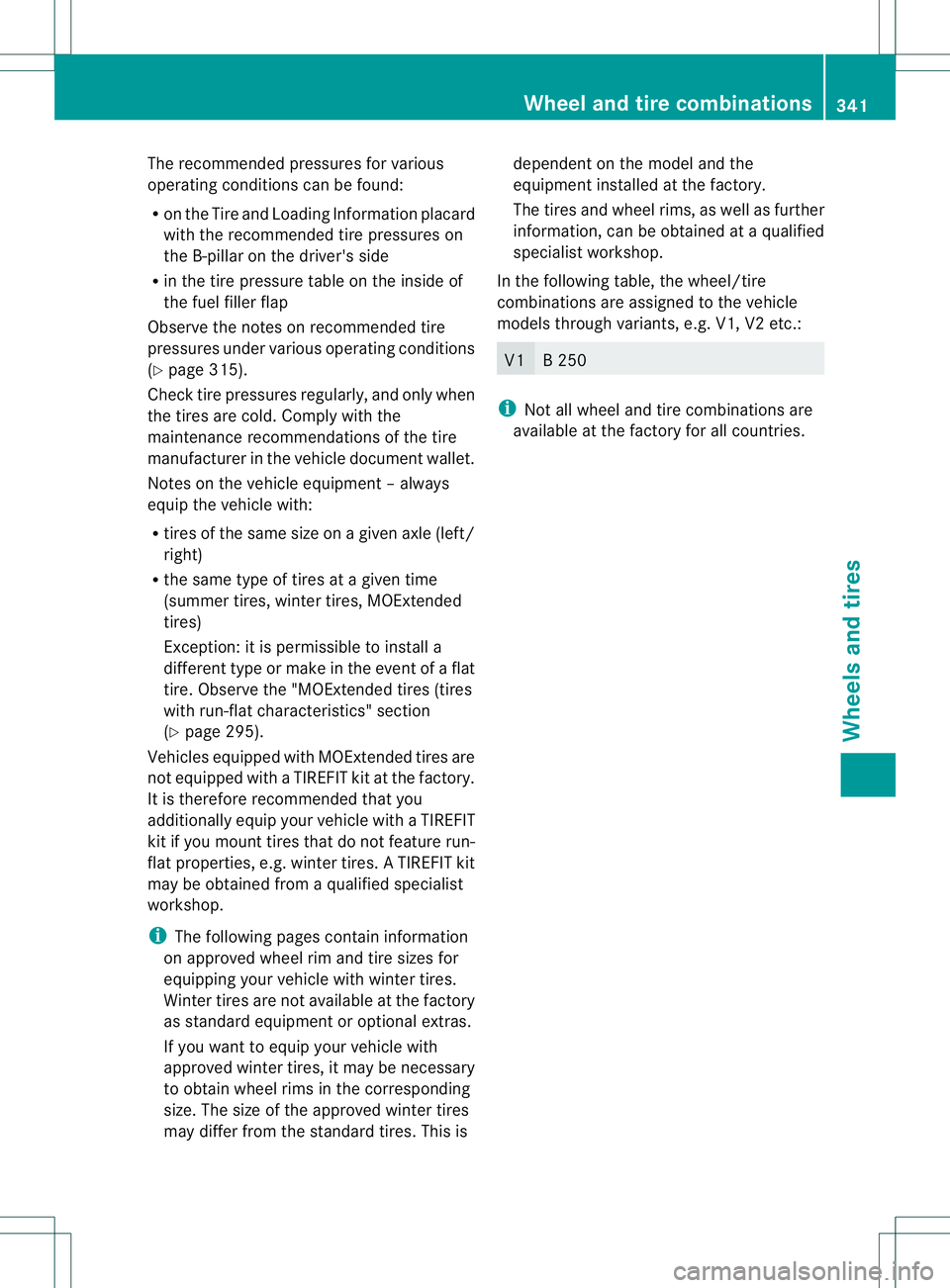
The recommended pressures for various
operating conditions can be found:
R
on the Tire and Loading Information placard
with the recommended tire pressures on
the B-pillar on the driver's side
R in the tire pressure table on the inside of
the fuel filler flap
Observe the notes on recommended tire
pressures under various operating conditions
(Y page 315).
Check tire pressures regularly, and only when
the tires are cold. Comply with the
maintenance recommendations of the tire
manufacturer in the vehicle document wallet.
Notes on the vehicle equipment –always
equip the vehicle with:
R tires of the same size on agiven axle (left/
right)
R the same type of tires at agiven time
(summer tires, winter tires, MOExtended
tires)
Exception: it is permissible to install a
differen ttype or mak einthe event of aflat
tire. Observe the "MOExtended tires (tires
with run-flat characteristics" section
(Y page 295).
Vehicles equipped with MOExtended tires are
not equipped with aTIREFIT kit at the factory.
It is therefore recommended that you
additionall yequip your vehicle with aTIREFIT
kit if you mount tires that do not feature run-
flat properties, e.g. winter tires. ATIREFIT kit
may be obtained from aqualified specialist
workshop.
i The following pagesc ontain information
on approved wheelr im and tire sizes for
equipping yourv ehicle with winter tires.
Winter tires are not available at the factory
as standard equipment or optional extras.
If you want to equip your vehicle with
approved winter tires, it may be necessary
to obtain wheel rims in the corresponding
size. The size of the approved winter tires
may differ from the standard tires. This is dependen
tonthe model and the
equipment installed at the factory.
The tires and wheel rims, as well as further
information ,can be obtained at aqualified
specialist workshop.
In the following table, the wheel/tire
combinations are assigned to the vehicle
models through variants, e.g. V1, V2 etc.: V1 B2
50 i
Not all wheel and tire combinations are
available at the factory for all countries. Wheel and tire combinations
341Wheels and tires Z
Page 344 of 360
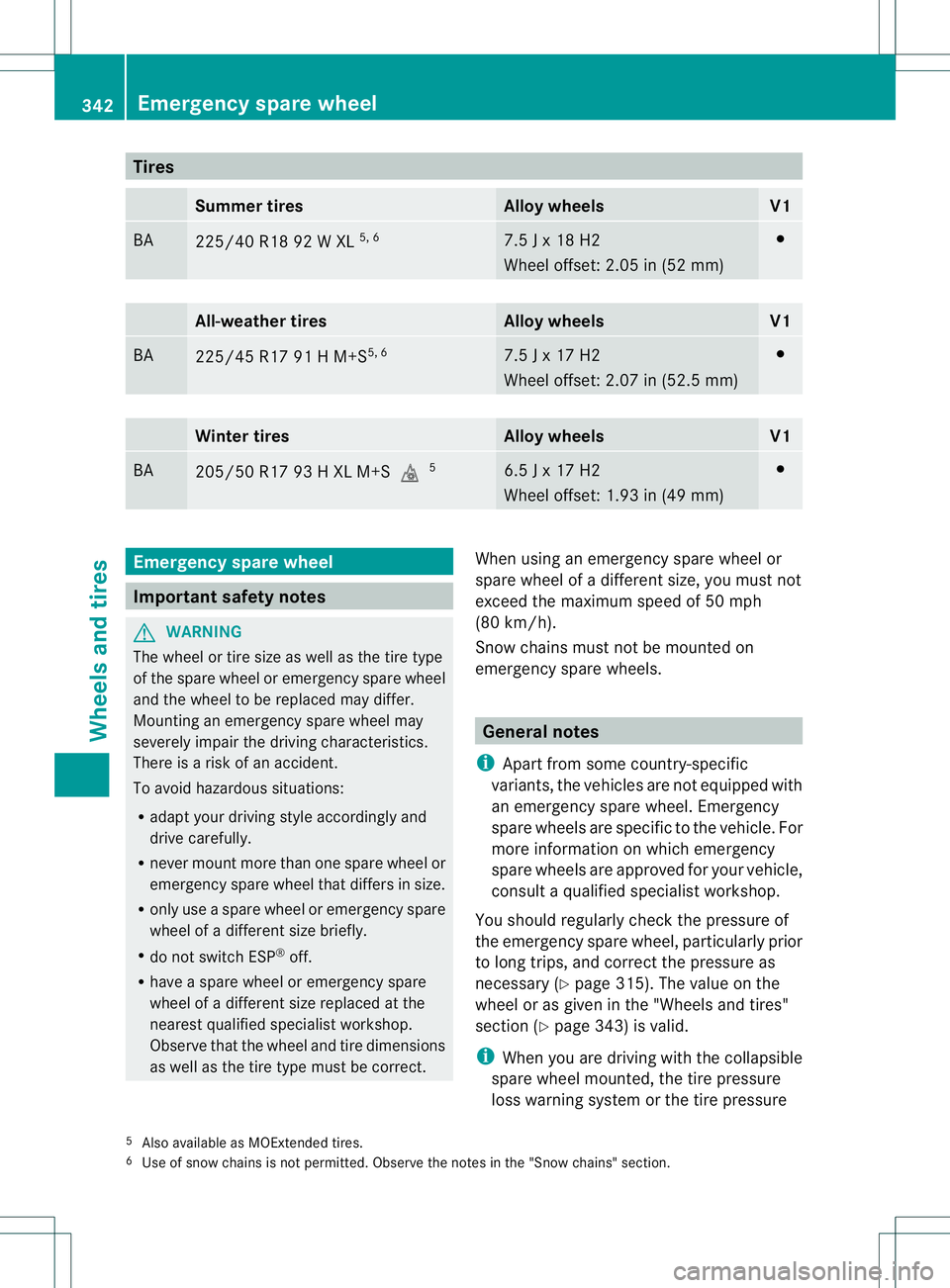
Tires
Summe
rtires Allo
ywheels V1
BA
225/40 R18 92
WXL5, 6 7.5
Jx18H2
Whee loffset: 2.05 in (52 mm) 0012
All-weather tires Alloy wheels V1
BA
225/45 R17 91
HM+S5, 6 7.5
Jx17H2
Whee loffset: 2.07 in (52.5 mm) 0012
Winte
rtires Alloy wheels V1
BA
205/50 R17 93
HXLM+S000E 5 6.5
Jx17H2
Whee loffset: 1.93 in (49 mm) 0012
Emergency spare wheel
Important safety notes
G
WARNING
The wheel or tire size as wel lasthe tire type
of the spare wheel or emergency spare wheel
and the wheel to be replaced may differ.
Mounting an emergency spare wheel may
severely impair the driving characteristics.
There is arisk of an accident.
To avoi dhazardou ssituations:
R adapt you rdriving style accordingly and
drive carefully.
R never mount more than one spare whee lor
emergency spare whee lthat differs in size.
R only use aspare whee loremergency spare
whee lofad ifferent size briefly.
R do not switch ESP ®
off.
R have aspare whee loremergency spare
whee lofad ifferent size replaced at the
nearest qualified specialist workshop.
Observe that the whee land tire dimensions
as wellast he tire type must be correct. When using an emergency spare whee
lor
spare whee lofadifferent size, you must not
exceed the maximu mspee dof50m ph
(80 km/h).
Snow chains must not be mounted on
emergency spare wheels. General notes
i Apart from some country-specific
variants, the vehicles are not equipped with
an emergency spare wheel. Emergency
spare wheels are specifi ctothe vehicle. For
more information on which emergency
spare wheels are approved for your vehicle,
consult aqualified specialist workshop.
You should regularly check the pressure of
the emergency spare wheel, particularly prior
to long trips, and correct the pressure as
necessary (Y page 315). The value on the
wheel or as given in the "Wheels and tires"
section (Y page 343) is valid.
i When you are driving with the collapsible
spare wheel mounted, the tire pressure
loss warning system or the tire pressure
5 Also available as MOExtended tires.
6 Use of snow chains is not permitted. Observe the notes in the "Snow chains" section. 342
Emergency sparew
heelWheels and tires
Page 349 of 360
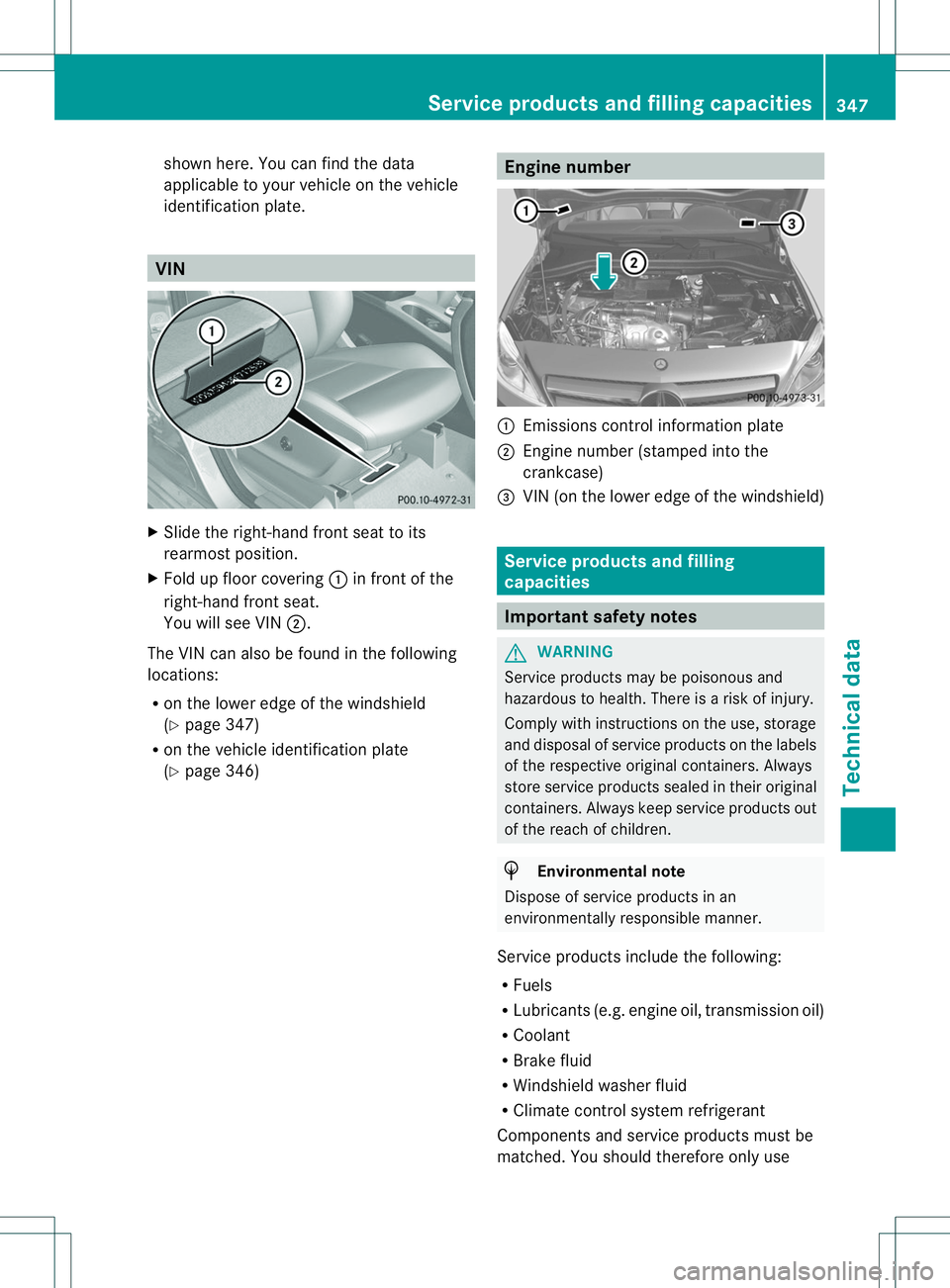
shown here. You can find the data
applicable to your vehicle on the vehicle
identification plate.
VIN
X
Slide the right-hand front seat to its
rearmost position.
X Fold up floor covering 001Ain front of the
right-hand front seat.
You will see VIN 0010.
The VIN can also be found in the following
locations:
R on the lower edge of the windshield
(Y page 347)
R on the vehicle identification plate
(Y page 346) Enginen
umber 001A
Emissions control information plate
0010 Engine number (stamped into the
crankcase)
0023 VIN (on the lower edge of the windshield) Service products and filling
capacities
Important safety notes
G
WARNING
Service products may be poisonous and
hazardous to health. There is arisk of injury.
Comply with instructions on the use, storage
and disposal of service products on the labels
of the respective original containers. Always
store service products sealed in their original
containers. Always keep service products out
of the reach of children. H
Environmental note
Dispose of service products in an
environmentally responsible manner.
Service products include the following:
R Fuels
R Lubricants (e.g. engine oil, transmission oil)
R Coolant
R Brake fluid
R Windshield washer fluid
R Climate control system refrigerant
Components and service products must be
matched. You should therefore only use Service products and filling capacities
347Technical data Z